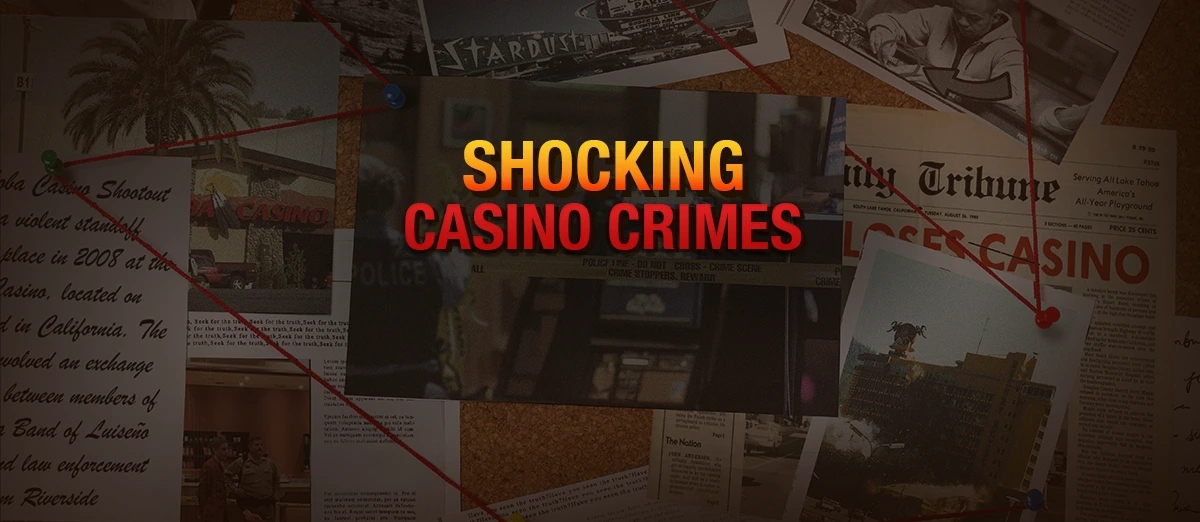Top 5 Audacious Casino Crimes That Shook the Gambling World

In 1980, a disgruntled gambler devised an elaborate scheme involving a homemade bomb so complex that even the FBI struggled to disarm it. He walked it into Harvey’s Resort Hotel in Nevada in broad daylight and walked straight out before laying out his terms for disposal. His demand? A multi-million-dollar ransom. The crime played out like a Hollywood thriller, complete with high stakes, intricate planning, and a dramatic conclusion.
But Harvey’s Casino bomb is just one of many jaw-dropping cases where criminals have tried to outplay the house. Land based casinos have always been places of risk and reward, where fortunes can change in an instant. But beyond the glamour of high-rolling gamblers and dazzling lights, gambling venues have also been the stage of some of the most audacious and shocking crimes in history. From elaborate heists to violent standoffs, these stories capture our imagination because they often blur the line between genius and recklessness, strategy and desperation.
Casino-related crimes hold a unique grip on public fascination. Unlike ordinary bank heists or street-level fraud, these crimes unfold in a world designed for illusion and excitement, where every turn of a card or spin of the wheel carries the promise of incredible wealth. The very nature of casinos—where vast sums of money change hands daily, and the psychology of risk is ever-present—makes them both a tempting target and the perfect setting for high-octane criminal plots. Some are meticulously planned, others reckless acts of impulse, but all share a sense of theatricality that makes them unforgettable.
From high-tech scams to brazen robberies, the following cases prove that when it comes to crime, the house doesn’t always win.

1. Harvey’s Resort Bombing: A High-Stakes Act of Terror
In August 1980, Harvey’s Resort Hotel and Casino in Stateline, Nevada, became the target of one of the most elaborate and destructive extortion attempts in casino history. The mastermind behind the crime was John Birges, a disgruntled gambler and failed businessman who had lost a fortune at Harvey’s. Seeking revenge (and a massive payday) he constructed a sophisticated bomb and delivered it to the casino, demanding a $3 million ransom.
Birges and his accomplices wheeled the device, disguised as a large copy machine, into the casino’s executive offices. But this was no ordinary explosive—it was a meticulously designed, tamper-proof bomb containing nearly 1,000 pounds of dynamite. The device featured multiple triggering mechanisms, including pressure switches that would detonate it if moved or tampered with. A ransom note left with the bomb demanded that the casino pay up if they wanted to avoid annihilation.
Law enforcement, including the FBI and bomb disposal experts, was quickly called in to assess the threat. Specialists found a bomb unlike anything they had encountered before. Efforts to disarm it were complicated by its sophisticated design—any attempt to lift or open it could trigger a devastating explosion. FBI agents and bomb technicians spent hours analyzing the device, but ultimately, their attempts to disable it failed.
On August 27, 1980, after unsuccessful attempts to defuse, the bomb detonated, tearing through the casino’s second floor and causing catastrophic damage. While the explosion was powerful enough to destroy much of the building, miraculously, no one was killed or seriously injured. The casino had been evacuated as a precaution, preventing what could have been a massive loss of life.
Investigators quickly set their sights on Birges after one of his sons tipped off authorities about his involvement. Within months, Birges was arrested, along with several accomplices. He was convicted of extortion and other charges, receiving multiple life sentences. He died in prison in 1996.
The Harvey’s Casino bombing remains one of the most dramatic and destructive crimes against a casino. It was a chilling example of how far a desperate gambler can go for revenge and money—and a stark reminder that, in the world of high-stakes crime, sometimes (often) the most audacious schemes end in disaster.
2. The Stardust Casino Skimming Operation: The Mob’s Secret Jackpot
Throughout the 1970s and early 1980s, Las Vegas was a city where organized crime still had a strong grip on the casino industry. One of the most notorious cases of mob infiltration was the skimming operation at the Stardust Casino, a scheme that saw millions of dollars siphoned off the books and into the pockets of the Chicago Outfit and various other crime families. This sophisticated operation, which ran for years, was ultimately dismantled by the FBI in one of the most significant crackdowns on mob-controlled casinos in history.
The Stardust, one of the most famous casinos on the Las Vegas Strip, was owned by the Argent Corporation, a company secretly controlled by mob-connected businessman Allen Glick. However, Glick was merely a figurehead—real power lay with Frank "Lefty" Rosenthal, a gambling expert and mob associate who ran the casino’s day-to-day operations.
The skimming scheme was relatively simple but highly effective. Cash from table games and slot machines was removed before it could be officially recorded, avoiding taxation and regulatory scrutiny. This "off-the-books" money was then funneled through a network of couriers and middlemen, ultimately ending up in the hands of organized crime syndicates, including those in Chicago, Kansas City, Milwaukee, and Cleveland. Millions of dollars were stolen in this manner over the years.
Law enforcement, led by the FBI, had long suspected organized crime involvement in Vegas casinos, but proving it wasn’t easy. Investigators spent years gathering evidence, using wiretaps, surveillance, and informants to build a case. The breakthrough came when the FBI managed to infiltrate the courier network, tracking money as it was being smuggled out of the Stardust and into mob-controlled operations across the country.
In the early 1980s, a federal crackdown led to the indictment and conviction of multiple key figures, including mob bosses, casino executives, and money couriers. Frank Rosenthal avoided major prison time, but similarly to his influence in Las Vegas, Lefty’s life ended in 2008. The Stardust itself continued operating for years, before eventually being closed and demolished in 2006.
The Stardust skimming operation remains one of the largest and most infamous cases of organised crime corruption in casino history. It exposed the extent to which the mob had infiltrated Las Vegas and led to significant reforms, tightening regulations and reducing mob influence in the city’s casino industry. The case even inspired elements of Martin Scorsese’s 1995 film Casino, immortalizing the Stardust scandal in popular culture.
3. The Bellagio Biker Bandit: A High-Speed Heist Gone Wrong
On December 14, 2010, Las Vegas witnessed one of the most daring solo casino heists in its history when a man in a motorcycle helmet stormed into the Bellagio Resort & Casino, one of the city’s most prestigious casinos, and made off with $1.5 million worth of high-value chips. The crime, which seemed straight out of a Hollywood movie, earned him the nickname the “Biker Bandit.” But his luck didn’t last long, as his reckless behavior in the aftermath led to a swift downfall.
At around 3 a.m., a man later identified as Anthony Carleo rode up to the Bellagio’s entrance on a motorcycle. Wearing a black helmet and armed with a handgun, he walked directly to a high-stakes craps table, brandished his weapon, and ordered the dealers to hand over their most valuable chips. These chips had denominations as high as $25,000, but of course they couldn’t be used outside the Bellagio.
The entire heist took less than three minutes. Carleo then ran back to his parked motorcycle and sped off into the night, disappearing before security could react. Surveillance footage captured the entire incident, but with his face obscured, investigators initially had little to go on.
Despite the dramatic nature of the daring casino heist, law enforcement—including Las Vegas Metro Police and the FBI—quickly identified key weaknesses in Carleo’s plan. High-denomination casino chips are nearly impossible to cash anonymously, as they are tracked by the casino and require identification for redemption.
Carleo, the son of a prominent Las Vegas judge, soon began flaunting his stolen wealth and gambling recklessly. His biggest mistake was trying to sell the stolen chips online. He reached out to an undercover officer posing as a buyer, offering to exchange $25,000 chips for a fraction of their value in cash.
Authorities set up a sting operation, and Carleo was arrested in February 2011. He later confessed to the Bellagio heist, as well as a similar robbery at the Suncoast Casino weeks earlier.
Carleo pleaded guilty to armed robbery and was sentenced to up to 16 years in prison. His case became a cautionary tale of how even the boldest casino crimes are rarely successful. While the heist itself was well-executed, his inability to cash in on his stolen chips ensured his eventual capture.
4. The Ritz Casino Hacking Scam: High-Tech Cheating at Its Finest
In 2004, London’s prestigious Ritz Casino became the target of a sophisticated high-tech scam that saw a small group of gamblers walk away with over £1.3 million in winnings. But unlike traditional casino heists, this wasn’t a case of armed robbery or stolen cash. Instead, the perpetrators used cutting-edge technology to beat the system without even breaking the law.
The scam centered around a technique called "sector targeting," a method used to predict where a roulette ball would land. The perpetrators—two Serbian men and a Hungarian woman—used a concealed laser scanner inside a modified mobile phone to measure the speed of the spinning ball and the wheel. This data was then fed into a computer, which ran rapid calculations to determine which section of the wheel the ball was most likely to land in.
Armed with this information, the trio placed their bets at the last possible moment before the ball dropped into a numbered pocket. By narrowing down the range of possible outcomes, they dramatically increased their chances of winning, turning what is usually a game of pure chance into one of near-certainty.
Casino staff became suspicious after noticing the trio’s unusually high and consistent winnings. Over two nights, they walked away with a staggering £1.3 million, an amount far beyond normal statistical odds. The casino immediately contacted the police, suspecting some form of cheating.
The trio were arrested and their hidden roulette devices were seized. However, investigators quickly realized that the players had not actually interfered with the wheel or the ball—meaning they hadn’t technically cheated. Instead, they had simply used physics and technology to gain an advantage.
After months of investigation, authorities concluded that no existing law had been broken. Since the group had not tampered with the game itself—only used observational technology—the case was ultimately dropped, and they were allowed to keep their winnings.
The Ritz Casino scam remains one of the most fascinating cases of technology being used to outsmart the house. It also raised serious concerns within the casino industry, prompting many establishments to tighten their security measures and safeguard against similar predictive techniques. While traditional casino crimes rely on brute force or deception, this case proved that sometimes, the smartest criminals don’t need to steal—they just need to think ahead.
5. The Crown Casino Betting Scam: A High-Stakes High-Tech Heist
In 2013, Melbourne’s Crown Casino became the center of one of the most sophisticated betting scams in gambling history. A high-stakes gambler, in collaboration with an insider, managed to cheat the system and walk away with $33 million AUD in just eight hands of cards. Unlike common casino heists that rely on deception mainly, this scam was a carefully orchestrated mix of technology, insider knowledge, and precise execution.
The main player in the operation was an unnamed VIP gambler, believed to be a foreign high roller, who was staying in one of Crown’s luxurious private villas. As a high-stakes player, he had access to exclusive gaming areas, where he played in near-total privacy.
Unbeknownst to casino staff, the player had an accomplice inside Crown’s security operations. This insider had access to the casino’s high-tech surveillance system, which monitors every table in real-time. The scam relied on hacking into the security cameras trained on the card tables, allowing the accomplice to relay critical information about the dealer’s hands directly to the gambler. With this advantage, the player could place nearly perfect bets, winning millions within minutes.
The sheer speed and success of the gambler’s winnings quickly raised suspicions among casino executives. While winning streaks are not uncommon in high-stakes gambling, taking $33 million in just eight hands was unprecedented. A review of security footage and system logs revealed that someone had accessed internal surveillance feeds in real time, leading investigators to believe an inside job was in play.
Casino officials confronted the gambler, who was asked to leave the premises immediately. However, due to legal complexities, no immediate charges were filed, and much of the money was never recovered. Crown Casino chose to remain tight-lipped about many details, possibly to avoid reputational damage.
Though law enforcement agencies, including Australian authorities, investigated the case, it’s unclear whether the gambler or the accomplice faced serious legal consequences. The scam exposed vulnerabilities in even the most secure casinos, prompting Crown and other major gaming establishments worldwide to upgrade their surveillance and cybersecurity measures.
The Crown Casino betting scam remains one of the most brazen uses of technology in casino cheating history. It proved that even in the age of digital security, the house isn’t always in control.

The Inevitable Downfall of Casino Criminals
Casinos have long been hotspots for thrilling crime stories, blending risk, reward, and high-stakes drama. From the explosive Harvey’s Casino bombing to sophisticated high-tech scams, these cases reveal the audacity and ingenuity of criminals who dared to challenge the house. Whether driven by desperation, greed, or sheer arrogance, their actions left lasting marks on the gambling world. While some managed brief success, most ended in failure, imprisonment, or worse. These extraordinary crimes serve as reminders that, no matter how cunning the scheme, the odds almost always favor the house. In the end, the biggest gamble is crime itself.





Review this Blog
Leave a Comment
User Comments
comments for Top 5 Audacious Casino Crimes That Shook the Gambling World